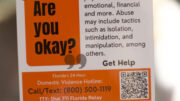By Amber James | gargoyle@flagler.edu
 One in every four women will experience domestic violence in her lifetime, according to the National Violence Against Women Survey.
One in every four women will experience domestic violence in her lifetime, according to the National Violence Against Women Survey.
This woman could be your sister or mother, your next door neighbor, the cashier at the supermarket, the sales associate who starts you a dressing room. She could be your best friend, your boss’s wife or your co-worker. She could be … the model in an advertisement in a favorite fashion magazine, trying to sell a suit or haircut at the expense of domestic violence.
There is a recent trend among advertisers to set their client’s product and company apart. But apart doesn’t necessarily mean edgy or right.
I’m rarely offended. In fact I thought I was “unoffendable.”
Give me the little boy in pink toenail polish featured in the J. Crew ad emailed to customers earlier this year, and I just smile.
Even Dolce and Gabbana’s 2007 advertisement of a woman being pinned down surrounded by men, which was pulled after international protest, didn’t offend me.
Call me gullible, but I could see Dolce and Gabbana’s vision for the advertisement as “an erotic dream, a sexual game,” and not a display of sexual violence. Just because he was holding her down, didn’t mean it was inherently violent. And Dolce and Gabbana ads are infamous for their sexually obvious content anyways.
But the advertisements that I’ve seen recently have been different, brasher, more apparent and more visible.
What do I mean by more visible? It’s quite literal actually.
Fluid hair salon in Edmonton, Alberta, Canada, has an ad that features a dashing young man behind a beautiful young woman with fabulous hair. The one thing that’s off? A black and purple shiner exhibited on the female model’s right eye.
That is shocking enough, but to add to the horror, the man is holding up a glorious necklace as a sort of “make-up” gift, and worse, the slogan is, “Look good in all you do.”
How can a woman, physically battered and probably emotionally much more battered, look good?
Her mental health and self respect is looming over a dangerous cliff.
Jill Scheyk, founder of About Yes That Jill Communications followed the progression of the ad campaign from its boycotts to the creator’s mother’s reaction, and said in her blog:
“I imagine that whoever did these ads told Fluid Hair it was ‘edgy’ and ‘exciting’ … Some people would have you believe that all press is good press. As a marketer — and as a human being with feelings — I can tell you this is not true. This kind of thing might get you a lot of attention, but it will also undoubtedly hurt your brand.”
“In reality, this is a picture on a computer or a piece of paper of a woman sitting on a couch with interesting hair and a painted black eye and a man standing behind the couch holding a necklace,” Phyllis Jackson, mother of Tiffany Jackson, the publicist behind the shoot, posted on Facebook.
This is true, but what it stands for, what it represents, is much more important.
Ashley Knaff, a graphic design major at Flagler College, is a “Glee” fanand a fan of Tyler Shields photography.
She says Shields does a lot of photos in the backdrop of horror and likes his style. But she could not believe her eyes when she saw Heather Morris, one of the stars of Glee, in a Tyler Shields pictorial.
Exhibiting a similar black and purple bruise as the Fluid salon ad, massively displayed on her left eye, Morris is tied up with the cord of an iron held by an overtly masculine clenched fist. The iron, no doubt, being an icon of domesticity.
In other photos, Morris is clearly wearing a ’50s style white-and-black polka dot dress.
On Tyler Shields website, a “befuddled” reader commented, “I do.not.get.it. Why do you keep producing photos glamorizing violence against women? There is absolutely nothing new or revelatory about pics like this. Take a look at the women being fed into a meat grinder or on a dog leash on the cover of Hustler in the 1970s. These photos are mere replicas of that antiquated sensibility. They no longer shock, and they never enlightened. They just perpetuate images of battered women. Can you please explain why you’re so stuck in the dark ages?”
People will always interpret photos, movies and art how they want.
“Caitlin” says on Shield’s website, “She has a black eye, so what. Kids come home with bruises everyday. In fact right now I have a black eye from playing sports. Tyler Shields I believe is not glorifying or condoning foul play in any sort of manner. His work is amazing and very different. Deal with it.”
As someone who is close with a beautiful woman who has experienced domestic violence to the brink of death, I cannot agree. You don’t come home with bruises like this from headbutts in soccer and nudges in softball. These kinds of injuries come with threats of death, pistol whips and sexual struggles.
These photos and ads no longer shock, they are not edgy. But they are most certainly controversial.
They rip open scars, and they try to idealize something that is horrifyingly truthful — a truth that has existed since the beginning of time.




Be the first to comment on "New ads hinting at domestic violence offends the ‘unoffendable’"